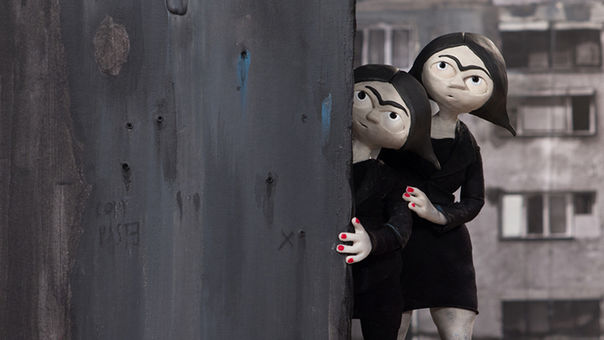Untravel
Mirela Vasileva

Ana Nedeljković and Nikola Majdak Jr.’s clay animation UNTRAVEL / NEPUTOVANJA (2018) is screened as part of the International Short Film Competition of the 24th Sarajevo Film Festival. The Belgrade-born screenwriter Nedeljković (1978) and the Ljubljana-born DoP Majdak (1972) have already worked together on RABBITLAND (2013), installations, and exhibitions, which have been warmly welcomed at various festivals.
Like many films from the region, UNTRAVEL deals with contemporary feelings about the past. The narrator is a young girl (you may recognize her from The Evil Girl Project), who lives a boring and pointless life in a non-identified country (“a small isolated country, just a few borders from you”), surrounded by patriotic propaganda. Instead of evil, now she is lost and confused. The story follows her desire to travel to a place called Abroad that might be a sunny paradise far away, or just the unknown other side of the big red brick wall that surrounds her city. The animation gives the authors the opportunity to explore the problems of isolation and desire by putting them in colors. The first shot shows us a clear blue sky, but then we view the grim buildings underneath it and a black liquid that forms a small river along the streets. For the girl everything seems bleak and dull in her small gray room in a small gray town. The possibility of something new and exciting comes from the objects we see painted in red – the chance of travel (the red bus, the passport), a crossed-out brand (on her laptop and clothing) and the red border around the city, that separate the girl from the desired abroad. The red may also signify the danger of what the new and unknown might be.
The impossibility of crossing the tall red border in real life makes the girl go over it in her dreams. In her dreams there is the sea, blue as the sky, and a red bus, which can take you to the wonderful land of Abroad. But there is also an angry border-control officer and the view from the hotel window, suspiciously similar to her hometown, which raise the question of whether this is the abroad she dreams of. The film is interested in the ideas of dreams and reality, of freedom and fear. The bleak look of her home country is put against the red – welcoming, but at the same time possibly dangerous. The treatment of the themes of freedom and borders is rich and ambiguous. There are the geographical borders of the countries, but also the borders made out of fear, as well as the borders we create for ourselves.
The clay figure of the girl seems small and helpless compared to the big red wall, surrounding her city. Only when a lot of other girls like her (literally like her – the animation uses the same doll for all the girls), who have similar dreams gather together, their courage makes them challenge the concept of border. And it turns out it is really just a concept. The last scene of the film shows us that borders are not real – just a man-made idea to keep people in certain places. When together with the other girls our protagonist finds out about that, and they start playing with the red lines, because lines are nothing but drawings on the ground. So why do they exist? Maybe only to keep the illusion for us, that there might be a place called Abroad, where life will be brighter, so we can have something to dream of.

